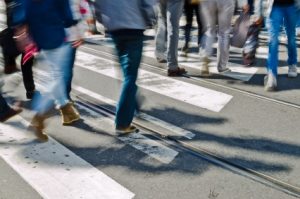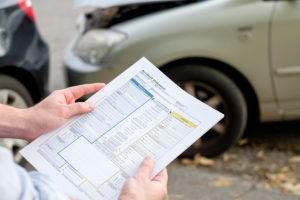Here’s a true statement: No pedestrian deserves to be struck by a motor vehicle. Not when crossing a street. Not when walking beside a road. Not when carrying groceries in a parking lot. Never.
We make this point because sometimes it seems like it’s a truth drivers would prefer to ignore. After a traffic accident in which a pedestrian has (inevitably) suffered serious, perhaps even fatal, injuries, drivers frequently argue that they, not the pedestrian, had the right of way.
But even if they’re correct about that (and frequently they’re not), it does not matter. Drivers must always yield to, and take reasonable care not to strike, pedestrians in and near the roadway. It’s that simple.
This shouldn’t come as any surprise to drivers, but sometimes it does, and that’s worth addressing. So take a look with experienced pedestrian accident lawyers in regards to pedestrians have the right of way, when they do not, and why the distinction does not matter as much as drivers think it does when it comes to pedestrian accident victims’ rights to receive financial compensation for their injuries and losses.
What is the right of way?
The right of way, simply put, is the right to go first on the road. In all U.S. states, the applicable state traffic code says who has the right of way in any given traffic situation. Right-of-way rules exist for intersections, crosswalks, parking lots, crowded streets, and lonely rural roads.
When do pedestrians have the right of way?
At any location where a pedestrian has the right of way, drivers must yield to the pedestrian by slowing or stopping.
Traffic codes differ from state to state, so the specific situations in which a pedestrian has the right of way are not uniform.
However, in most states, pedestrians have the right of way on a public road at:
- An intersection with a stop sign.
- An intersection with a red light and/or a walk signal.
- A point on a road where the pedestrian would be in danger if not given the right of way.
In many states, pedestrians also have the right of way on a public road at:
- A designated, non-intersection crosswalk.
- A point on the road with no designated crosswalk but which is a safe location for pedestrians to cross.
Pedestrians accompanied by a guide dog or who use a cane to assist with vision impairment frequently have the right of way on a public road. Pedestrians also usually have the right of way on sidewalks and walking paths and in parking lots.
Drivers must know the rules of the road in the states where they drive, and, when in doubt, should assume that pedestrians have the right of way.
When do pedestrians not have the right of way?
Pedestrians, like all road users, must follow the rules of the road. At a road location where a pedestrian does not have the right of way, the pedestrian must yield to vehicles and may only enter the roadway when it is safe to do so without disrupting vehicle traffic.
As above, state traffic codes differ, so there is no single set of rules about when pedestrians do not have the right of way.
In general, however, pedestrians do not have the right of way:
- At intersections with a green light and/or a no-walk signal.
- On limited access highways like interstates, expressways, or parkways (which pedestrians usually cannot use).
In some states, pedestrians may also have an obligation to yield the right of way to vehicles at non-intersection crosswalks or on roads with no crosswalks.
Right of Way Rules Never Permit Drivers to Endanger or Hit Pedestrians
 Some drivers (cabbies in a certain large city come to mind) operate under the misconception that if they have the right of way, they can ignore, speed up around, or even hit pedestrians who fail to yield to them. This is absolutely untrue.
Some drivers (cabbies in a certain large city come to mind) operate under the misconception that if they have the right of way, they can ignore, speed up around, or even hit pedestrians who fail to yield to them. This is absolutely untrue.
No driver ever has the right to endanger or strike a pedestrian, regardless of who has the right of way. And a driver always must yield to a pedestrian who has stepped into the roadway, even if the pedestrian made a mistake by doing so.
There is no room for confusion on this point, so let’s dwell on it a little longer. Right-of-way rules facilitate traffic flow and ensure the safety of all road users, not just of the road user who has the right of way. They say who gets to go first on a public road, not who gets to cause others harm on it.
One person’s potential violation of a right of way rule does not give another person license to get into an accident with the violator. A driver’s right of way is not a free pass to do whatever the driver wants around a pedestrian.
Why is this important to emphasize? Because as we mentioned at the outset, drivers who strike pedestrians frequently blame the crash on the pedestrian’s supposed failure to yield the right of way as required under the applicable traffic rules.
Often, the driver is wrong—pedestrians have the right of way far more often than vehicles do when operating around pedestrians. But even if the driver is correct, the pedestrian’s mistake does not excuse unsafe or reckless driving that ends with the pedestrian getting hurt.
To be clear, we’re not saying pedestrian versus vehicle right of way never matters. It can, in some cases. But usually, it’s most relevant to the question of how obviously the driver was at fault for what happened. By violating the right of way rules, in other words, a driver makes it relatively easy for an injured pedestrian’s lawyer to prove the driver’s fault.
But the reverse is rarely true. A driver who has the right of way cannot expect to escape liability for hitting a pedestrian; the pedestrian victim’s lawyer may simply have to work a little harder to prove the driver’s fault.
An Injured Pedestrian’s Right to Financial Compensation
Here’s the upshot of the discussion above: If you got hurt in a pedestrian accident, do not give the question of whether you had the right of way at the road location where it happened more importance than it deserves.
In most pedestrian accident cases, a collision between a pedestrian and a vehicle happens because the driver, not the pedestrian, failed to take reasonable steps to avoid the accident. Never assume that you deserved to get hit by a car or that right of way rules will prevent you from receiving compensation for your injuries. Most of the time, that’s just not so.
Your legal rights as the victim of a pedestrian accident instead depend on a broader set of rules. Under the laws of most states, you will have the right to demand financial compensation for your injuries and losses from anyone whose unreasonably dangerous actions caused the accident that injured you as a pedestrian.
Regardless of who had the right of way, if the driver reasonably should have avoided hitting you, the chances are that you have a claim for damages to make against the driver (and potentially others—see below).
Additionally, you may have an absolute right to financial compensation, no matter what the driver could or should have done. In states with no-fault auto insurance laws, for example, the driver’s (or your own) personal injury protection (PIP) auto insurance will pay for at least some of your medical expenses and other losses as a pedestrian accident victim, regardless of whose fault the accident was.
Multiple Parties Could Owe You Money Damages
 Drivers who hit pedestrians usually bear at least some of the blame, which is why they (along with their insurance companies) usually owe at least some financial compensation to the injured victim. But drivers are not the only parties who may have legal liability for the injuries and losses the pedestrian suffered in a collision.
Drivers who hit pedestrians usually bear at least some of the blame, which is why they (along with their insurance companies) usually owe at least some financial compensation to the injured victim. But drivers are not the only parties who may have legal liability for the injuries and losses the pedestrian suffered in a collision.
Others could share, or even bear all of, that liability, including:
- The driver’s employer, if the driver struck the pedestrian with a work vehicle;
- A third party who somehow distracted or prevented the driver from operating safely around the pedestrian, leading to the accident;
- A local or state government, if an unreasonably dangerous feature of a public road contributed to causing the accident; or
- An owner of private property where a pedestrian accident happens (such as a parking lot) if a hazard on the premises prompted the accident.
In fact, someone could owe you financial compensation for your pedestrian accident injuries, even if there’s nothing the driver could have done to avoid hitting you.
For example, suppose you stepped onto the road at an intersection where the sight lines were so limited that a reasonable driver simply could not have seen you until it was too late. In that case, fault and liability for the accident may lie entirely with the government agency that designed and built such a dangerous intersection, regardless of who had the right of way where the collision occurred.
The most reliable way to find out who may owe you financial compensation for your pedestrian accident injuries is to speak with an experienced pedestrian accident lawyer as soon as you can after getting hurt. The lawyer may need to take quick action to protect your rights, so don’t delay. If need be, a spouse or close family member can reach out to a lawyer on your behalf.
You May Have the Right to Receive Significant Payments
Pedestrian accidents tend to cause severe injuries and large disruptions in the victim’s life. It’s not uncommon for pedestrian accident victims to suffer traumatic brain injuries (TBIs), spinal cord injuries (SCIs), broken bones, deep facial lacerations, and other trauma that requires extensive, expensive medical treatment and inflicts lifelong disabilities.
No matter what kind of injury you suffered as a pedestrian, the law entitles you to receive fair financial compensation.
In the typical case, that compensation can include payment for:
- Medical treatments you need to heal from your injuries and to address any related health complications in the future;
- Goods and services you need to help you live with or adapt to your injuries, either temporarily or permanently;
- The income you did not earn when you missed work to heal from your injuries, including the value of paid-time-off (PTO) you used;
- The income you probably will not earn in the future because of impairments and disabilities related to your injuries;
- Your physical pain, emotional suffering, loss of independence, and diminished quality of life.
In some cases, a lawyer may also secure statutory damages, which are fixed by law for specific legal violations by the party at fault, or punitive damages, which judges can award when the at-fault party caused your injuries through wanton or malicious conduct.
The money you may receive can vary widely, depending on factors like the nature of your injuries, the strength of the case a lawyer can build on your behalf, and the money and insurance the at-fault party has available to pay you. One thing, however, is certain: you will have the best shot at securing the maximum payment possible if you hire a skilled, experienced pedestrian accident attorney to represent you.
Don’t Worry About Your right of way. Instead, Contact a Pedestrian Accident Lawyer Today.

Pedestrian Accident Lawyer, Andrew Finkelstein
Many human beings tend to blame themselves for their misfortunes, even when what has happened to them is someone else’s fault. We all learn to look both ways and exercise caution before crossing the street, so in the aftermath of a pedestrian accident, victims sometimes question their own roles in what happened. Did they have the right of way? Should they have done something differently?
It’s natural to ask yourself these questions, but they should not stand in the way of you receiving the financial compensation you deserve for the injuries and losses you suffered when a vehicle hit you on the road. Regardless of who had the right of way at the spot where you got hit, chances are you have a right to seek money damages from those at-fault and their insurers.
